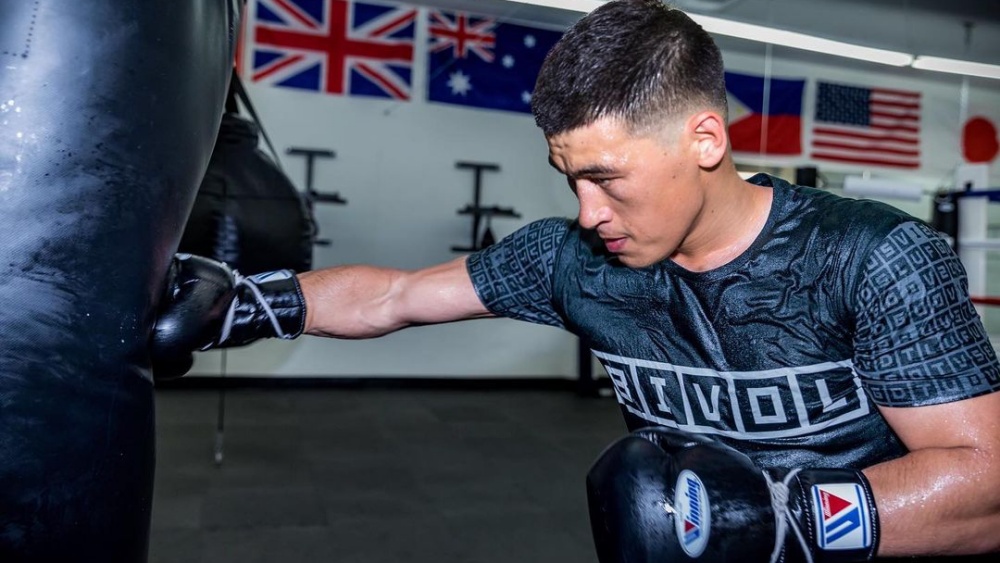
The Soviet boxing style was created during the days of the Soviet Union and revolves around strategic footwork, precise combinations, high-fight IQ, and keeping opponents at range. It’s a technique-driven boxing style that prioritizes fighting from outside range and controlling the fight’s tempo with sharp combination and footwork.
The typical soviet boxing style fighter has exceptional footwork, solid defense, and jab-heavy combinations. The style tends to favor taller, longer boxers since it involves spending most of your time inside the ring at outside range.
The Origins Of The Soviet Boxing Style
The Soviet boxing style was created out of necessity in a boxing landscape that was dominated by Western countries in the 20th century. Also known as the Eastern European or Russian style, it was developed by Soviet boxing coaches who wanted to create a system that equipped boxers with tools to deal with all the complexities that could unfold during a fight.
Over time, the style has gone on to represent the resilience and discipline many associated with the people from the regions that once fell under the Soviet Union’s banner. The soviet style has been extremely effective in modern times, with fighters like Wladimir Klitschko, Sergey Kovalev, and Dmitry Bivol dominating their respective divisions.
The Main Principles Of The Soviet Boxing Style
These days, the Soviet boxing style is one of the most respected approaches to boxing as it embodies the purest goal of the sweet science: hit but don’t get hit.
It’s not always the most fan-friendly approach since it is rare to see a Soviet-style boxer engage in mindless brawls inside the ring. Instead, this style emphasizes using good footwork and defense to avoid punches while using weapons like the jab and cross to pick opponents apart from range.
Some of the key principles of the Soviet boxing style include:
1) Prioritizing The Jab
The Soviet boxing style places a strong emphasis on the jab over all other punches. Jabs are thrown in a fast, snapping motion to score points and set up more powerful punches. The jab is also used to gauge distances to pave the way for more powerful strikes.
Boxers like Wladimir Klitschko were often criticized for only throwing jabs and an occasional cross during their fights, but their records show how effective prioritizing the jab can be.
2) The Unconventional Lead Hook
The long-range lead hook is another technique that characterizes the Russian boxing style. The technique involves throwing the lead hook almost as if it’s a jab and only turning at the very last moment.
It is often used as a surprise attack that can slip past the guards of experienced boxers. A small step might also be performed when executing the technique to help close the distance.
3) The Jab, Lead Hook Combo
This is one of the key combinations Soviet-style fighters use. The combination involves using a jab to set the hook up by getting your opponent to move their guard toward the front of their face to help close the distance.
It’s an excellent combination for scoring knockouts once you get the hang of it. You get your opponent to feel a false sense of security with the jab before throwing a powerful hook at them.
4) Pendulum Bounce
The Soviet boxing style incorporates a footwork technique called the pendulum bounce. This involves a boxer constantly shifting their weight as they bounce back and forth on the balls of their feet while moving their upper body and head to avoid punches.
The pendulum bounce helps to create deceptive angles you can attack from, and it often leaves opponents struggling to predict what your next move will be. However, the pendulum bounce requires lots of practice to master.
5) Attacking While Moving
Another impressive feature of the Russian boxing style is throwing punches while moving backward or sideways. Moving away from an opponent typically reduces the power behind your punches, but you can make up for that with precise timing and accurate strikes. You might also get to use your opponent’s momentum against them if they’re chasing you down as you try to get away.
Learning how to strike while moving away from opponents creates openings for counterpunches while removing you from your opponent’s reach. It’s a tool Soviet-style boxers use to keep their opponents at outside range, along with their jabs.
The Legacy Of The Russian Boxing Style
Some of the most dominant champions in boxing’s history come from the Soviet style and it has been a huge reason for their success. For example, Dmitry Bivol was able to pull off an upset against Saul “Canelo” Alvarez by controlling the distance as the Russian style recommends and picking him apart from range with his long-reach weapons.
Oleksandr Usyk is another Russian-style boxer and his accomplishments inside the ring highlight how effective the approach can be regardless of weight classes.
Wladimir Klitschko is arguably the textbook definition of a Soviet-style boxer as he never strayed much from it throughout his career. He was rarely ever in danger inside the ring during his reign using his superior footwork to evade strikes and create angles, while picking his opponents apart with jabs and jab, cross combinations.
The Russian boxing style remains popular in modern boxing thanks to its emphasis on boxers mastering the fundamentals of boxing like making intelligent decisions and staying balanced as you throw punches and move around the ring.
The Soviet boxing style has been so effective inside the ring that the main criticism its detractors often have is that fighters from this background are sometimes reluctant to get into brawls. However, those who understand the sweet science know it has always been about hitting your opponent and not getting hit back. Very few styles compare to the Russian style when it comes to keeping true to this core boxing philosophy.
You may also like:
The Impact Of Boxing On Youth Development In Singapore
School can be a strenuous time for children, especially given the rough demands of constant studying and the pressure of attaining high marks. Yet it’s something that everyone goes through early on in their lives….
The fundamental goal of boxing is to hit your opponent without getting hit. Some boxers will tell you that being offensive is the best defense, but that’s not true. Throwing a punch creates openings for…
The Lion City is a bustling metropolis and in it, lies a vibrant sporting community, with boxing increasingly gaining prominence among its youth. This interest is not unfounded, as boxing in Singapore offers a unique…
Boxing is a lot more than simply trading blows with an opponent. It’s a sweet science that often breaks down into a chess match where the fighter who’s better at imposing their will over the…
In the heart of Southeast Asia, Singapore stands as a beacon of modernity, technological advancement, and a deep-seated commitment to health and wellness. Amidst the bustling city-state’s myriad fitness trends, boxing has emerged as a…
Having strong wrists is essential in boxing, whether you’re throwing punches at an opponent or working on a heavy bag. Your wrists carry a heavy load whenever you punch something hard, which is why boxers…
Brazilian Jiu-Jitsu is one of the few martial arts out there that stays highly effective regardless of one’s physical ability. The secret to this is that it’s not about overpowering your opponent with sheer strength…
Did you know that cross-training helps martial arts practitioners work out more efficiently? Cross-training involves mixing other sports activities that increase your fitness levels between your boxing, Muay Thai, BJJ, or mixed martial arts sessions…
An increasing number of young athletes are choosing to make mixed martial arts their primary sport as it continues to gain global mainstream recognition. Being an MMA fighter is a lot cooler, safer, and appealing…
Muay Thai is a sport that allows fighters to punch, kick, knee, and elbow each other to their heart’s content for up to five rounds, many of whom refuse to back down even after facing…
In Muay Thai, there are very few techniques that score higher than one where you dump your opponent down onto the canvas from the clinch. A dump hits almost all of the critical scoring criteria…
Strength training has become more popular in the past couple of decades as many old myths about what it does to your body have been debunked thanks to an improved understanding of how the body…


![Virat Kohli will be my favourite wicket to get in the IPL: LSG's latest recruit Naman Tiwari [Exclusive]](https://babu88sports.com/wp-content/uploads/2025/12/virat-kohli-will-be-my-favourite-wicket-to-get-in-the-ipl-lsgs-latest-recruit-naman-tiwari-exclusive-360x180.png)






























![Virat Kohli will be my favourite wicket to get in the IPL: LSG's latest recruit Naman Tiwari [Exclusive]](https://babu88sports.com/wp-content/uploads/2025/12/virat-kohli-will-be-my-favourite-wicket-to-get-in-the-ipl-lsgs-latest-recruit-naman-tiwari-exclusive-120x86.png)



![Virat Kohli will be my favourite wicket to get in the IPL: LSG's latest recruit Naman Tiwari [Exclusive]](https://babu88sports.com/wp-content/uploads/2025/12/virat-kohli-will-be-my-favourite-wicket-to-get-in-the-ipl-lsgs-latest-recruit-naman-tiwari-exclusive-350x250.png)